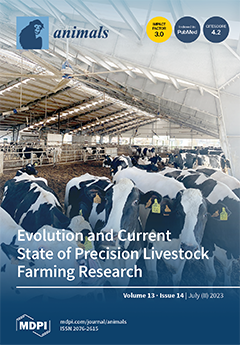In livestock research, there has been a growing interest in the impact of melatonin on both health and disease conditions. The hypothesis of the present study was that melatonin treatment prenatally could support the immune competence and growth of experimentally infected lambs. This is the first study that aimed to investigate the impact of melatonin administration throughout pregnancy on immunity and oocyst excretion of pre-partum ewes and their offspring after experimental infection with
Eimeria species. Thirty pregnant ewes were allocated into five equal groups, ΚΜ, ΚC, CM, CC, and NC, and gave birth to 47 lambs. Ewes of the KM and KC groups were orally challenged with a cocktail of
Eimeria-sporulated oocysts (mainly consisting of
Eimeria ovinoidalis), on day 120 of pregnancy, as well as all the lambs at the age of 5–9 days apart from those born from the NC group (environmental control). Fecal samples were collected from all ewes before infection and at parturition and from all lambs 14 times (S0–S13), before infection and during the following 8 weeks, for counting oocysts per gram of feces (OPG). Immunoglobulin (IgG) and cytokine (IL-1β, IL-6, IL-10, IFN-γ) levels were determined in ewes’ plasma collected before infection and at parturition, in lambs’ plasma at 24 and 72 h after their birth, and in colostrum samples at parturition and 72 h later. Body weight of lambs was recorded five times from birth until the age of 60 days. Accordingly, the leucogram was evaluated in blood samples collected six times within the same period. On average, IgG concentration was higher (
p < 0.05) in the blood of KM-ewes compared to KC and CC groups and in colostrum of KM-ewes compared to other groups (
p < 0.001). KM-lambs had greater IgG titer and IFN-γ level than the other groups (
p < 0.05). The IL-10/ IFN-γ ratio in KM-ewes was lower than the CC group (
p = 0.06). Overall, the growth rate of lambs did not differ among groups (
p > 0.05). Total oocysts’ excretion in KM- and CM-lambs was reduced by 94.9% (
p = 0.05) and 92.6% (
p = 0.025), respectively, compared to KC-lambs, following the 3-week period after challenge, when
E. ovinoidalis predominated in all groups. The dominant type of leucocytes was monocytes in all experimentally infected lambs, but not in NC-lambs, while overall lymphocytes were lower in KC-lambs than in NC-lambs (
p < 0.05). Considering that almost all young indoor-reared lambs are exposed to coccidia species during their early life, melatonin treatment prenatally could suggest an alternative management tool in alleviating infection pressure.
Full article






